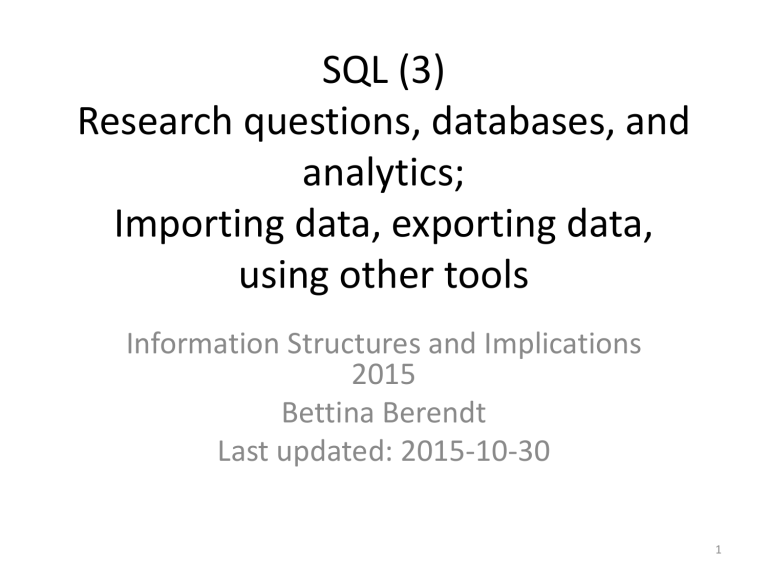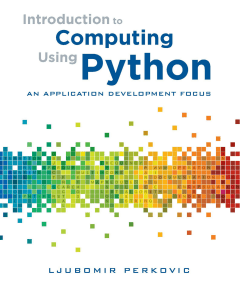
SQL (3)
Research questions, databases, and
analytics;
Importing data, exporting data,
using other tools
Information Structures and Implications
2015
Bettina Berendt
Last updated: 2015-10-30
1
Where are we?
2
Agenda
1.
2.
3.
4.
5.
6.
Our goal: answer interesting questions
Changing databases – a design view
Importing, and more on combining data
Creating analytics and storing their values
Exporting data
Putting it all together: From goal to flowchart of
data and processing steps
7. Preview: Database connectivity – (Python and
other) programs and databases
3
How many parliamentarians does each
country have?
Number of Parliamentarians
500
450
400
350
300
250
200
150
100
50
0
4
How long are political functions held,
on average?
Average time the position was held, in years
lp:Role/chair_of_the_bureau
lp:Role/vice-chair/member_of_the_bureau
lp:Role/secretary_to_the_bureau
lp:Role/deputy_chair
lp:Role/substitute
lp:Role/co-chair
lp:Role/vice-chair
lp:Role/chair
lp:Role/member
lp:Role/treasurer
lp:Role/deputy_treasurer
0
1
2
3
4
5
6
5
How often do countries vote
for/against things? (Note: artificial data!)
100%
90%
80%
70%
60%
no
50%
yes
40%
30%
20%
10%
0%
IE
PT
GR
DE
ES
FR
GB
BE
DK
IT
LU
NL
6
Is there a relation between
length of time in office and age?
35000
Age at start of term (in days)
30000
25000
20000
15000
10000
5000
0
0
1000
2000
3000
4000
5000
6000
Time in office (in days)
7
Agenda
1.
2.
3.
4.
5.
6.
Our goal: answer interesting questions
Changing databases – a design view
Importing, and more on combining data
Creating analytics and storing their values
Exporting data
Putting it all together: From goal to flowchart of
data and processing steps
7. Preview: Database connectivity – (Python and
other) programs and databases
8
Incremental changes to databases
• Let us see how we can add information to an
existing database.
• Let us modify
– The conceptual model (EER)
– The logical model (relations)
– The physical model (database)
in turn
9
The diagram
10
Assume we have voting data
• Just some examples of real EU voting data
– http://www.elprg.eu/data.htm
– http://personal.lse.ac.uk/hix/ (overview, link to the
next one)
– http://www.votewatch.eu/
– http://www.itsyourparliament.eu/api/
• For simplicity, assume we have a CSV file
– If it‘s a different format, need some more
transformation
• For simplicity, I generated random data
11
Artifical voting data (votes2.csv: 504 votes)
12
Agenda
1.
2.
3.
4.
5.
6.
Our goal: answer interesting questions
Changing databases – a design view
Importing, and more on combining data
Creating analytics and storing their values
Exporting data
Putting it all together: From goal to flowchart of
data and processing steps
7. Preview: Database connectivity – (Python and
other) programs and databases
13
Adding these data to the database:
(1) Creating a new table
Table a_votes
(Missing: primary and foreign keys)
14
Adding these data to the database:
(2) Importing the data into the table
LOAD DATA INFILE
'C:\\Users\\kurt\\Documents\\Lehre\\ISI15\\Session 7 - SQL3\\votes2.csv'
INTO TABLE a_votes
FIELDS TERMINATED BY ';'
LINES TERMINATED BY '\n'
(Note: The file path specification is different on Mac.)
15
Note
• LOAD DATA INFILE is of course not only useful
for adding data to an existing database.
• You could also build a database from scratch
in this way.
16
Linking the new to the old data
(just another join)
17
Scenario 2 (more common in real life): Our new data do
not have the same key information as the old data
18
New table & data import for scenario 2
Table a_votes2
LOAD DATA INFILE
'C:\\Users\\kurt\\Documents\\Lehr
e\\ISI15\\Session 7 SQL3\\artificial_votes2.txt'
INTO TABLE a_votes2 FIELDS
TERMINATED BY '\t'
LINES TERMINATED BY '\n'
(Missing: primary and
foreign keys)
19
Sample data for scenario 2
20
Linking the new to the old data
(record linkage – not necessarily via the primary keys)
21
What are the risks and opportunities
of scenario 2?
22
Agenda
1.
2.
3.
4.
5.
6.
Our goal: answer interesting questions
Changing databases – a design view
Importing, and more on combining data
Creating analytics and storing their values
Exporting data
Putting it all together: From goal to flowchart of
data and processing steps
7. Preview: Database connectivity – (Python and
other) programs and databases
23
How many
parliamentarians
does each
country
have?
(Order the
result by
country name)
24
For how long do
parliamentarians
hold a political
function? (in days)
21,852 rows …
http://dev.mysql.com/doc/refman/5.7/en/date-and-time-functions.html
25
How long are positions held, on
average?
26
OK, minus and AVG and COUNTs are fine,
but what about more complex measures?
• For example, is there a relation between
– length of time in office
– and age?
(do older parliamentarians stay longer in office than
younger people, or vice versa)?
• You could investigate this hypothesis with the
help of the Pearson correlation coefficient
27
Pearson correlation
in SQL (1)
https://www.vanheusden.com/misc/pearson.php
28
Pearson correlation in SQL (2)
SELECT
user1, user2,
((psum - (sum1 * sum2 / n)) / sqrt((sum1sq - pow(sum1, 2.0) / n) * (sum2sq - pow(sum2, 2.0) / n))) AS r,
n
FROM
(SELECT
n1.user AS user1,
n2.user AS user2,
SUM(n1.rating) AS sum1,
SUM(n2.rating) AS sum2,
SUM(n1.rating * n1.rating) AS sum1sq,
SUM(n2.rating * n2.rating) AS sum2sq,
SUM(n1.rating * n2.rating) AS psum,
COUNT(*) AS n
FROM
testdata AS n1
LEFT JOIN
testdata AS n2
ON
n1.movie = n2.movie
WHERE
n1.user > n2.user
GROUP BY
n1.user, n2.user) AS step1
ORDER BY
r DESC,
n DESC
Don‘t worry, you will
probably never have to do
such a thing ...
https://www.vanheusden.com/misc/pearson.php
29
A general question:
Can you compute anything in SQL?
= Can you compute anything that can be
computed (by a programming language such as
python)?
• In principle, yes
(Theoretical result about Turing equivalence: cf.
http://stackoverflow.com/questions/900055/is-sql-or-even-tsql-turing-complete)
• So what do you need (e.g. python) programs
and other software for?
30
Answer: For example, to calculate your
analytics in more comfortable ways
Excel makes it very easy to calculate a
correlation
1. Create (in SQL) one or more tables with the
information
2. Export to CSV
3. Import/Load into Excel
4. Calculate the correlation coefficient there
31
Answer (2): or for generating a chart
1. Create (in SQL) one or more tables with the
information
2. Export to CSV
3. Import/Load into Excel
4. Create a chart
32
Agenda
1.
2.
3.
4.
5.
6.
Our goal: answer interesting questions
Changing databases – a design view
Importing, and more on combining data
Creating analytics and storing their values
Exporting data
Putting it all together: From goal to flowchart of
data and processing steps
7. Preview: Database connectivity – (Python and
other) programs and databases
33
How many parliamentarians does each
country have? (1)
SELECT name, count( * )
INTO OUTFILE
'C:\\Users\\kurt\\Documents\\Lehre\\ISI15\\Session 7 - SQL3\\countries_parliamentarians.csv'
FIELDS TERMINATED BY ‘;'
LINES TERMINATED BY '\n'
FROM represents, country
WHERE represents.countryacronym =
country.acronym
GROUP BY countryacronym
ORDER BY name
34
How many parliamentarians does each
country have? (2)
Number of Parliamentarians
500
450
400
350
300
250
200
150
100
50
0
35
How long are political functions held,
on average?
Average time the position was held, in years
lp:Role/chair_of_the_bureau
lp:Role/vice-chair/member_of_the_bureau
lp:Role/secretary_to_the_bureau
lp:Role/deputy_chair
lp:Role/substitute
lp:Role/co-chair
lp:Role/vice-chair
lp:Role/chair
lp:Role/member
lp:Role/treasurer
lp:Role/deputy_treasurer
0
1
2
3
4
5
6
36
Is there a relation between
length of time in office and age?
37
TimeInOffice / age (1): Option 1:
export the new table directly
SELECT datediff( End_date , Start_date) , datediff(
Start_date, date_of_birth )
INTO OUTFILE
'C:\\Users\\kurt\\Documents\\Lehre\\ISI15\\Sessio
n 7 - SQL3\\time2age.csv'
FIELDS TERMINATED BY ‘;'
LINES TERMINATED BY '\n'
FROM parliament_member, in_political_function
WHERE parliament_member.MEP_ID=
in_political_function.MEP_ID
38
TimeInOffice / age (2): And then
compute the correlation with Excel...
39
TimeInOffice / age (3): Option 2: Create a new table in
the database (which you can later export)
CREATE TABLE time_in_office2age
SELECT datediff( End_date , Start_date`) ,
datediff( Start_date`, date_of_birth )
FROM parliament_member,
`in_political_function`
WHERE parliament_member.`MEP_ID` =
`in_political_function`.`MEP_ID`
40
How often do countries vote for/against things? (1)
Basic queries (combining these into one query is a bit tricky, so I recommend to query and
export this separately): number of YESs grouped by country, number of Nos grouped by
country
SELECT countryacronym, count( * )
FROM parliament_member, represents, a_votes
WHERE parliament_member.MEP_ID = represents.MEP_ID
AND parliament_member.MEP_ID = a_votes.MEP_ID
AND member_vote LIKE ‘yes%'
GROUP BY countryacronym
ORDER BY countryacronym
SELECT countryacronym, count( * )
FROM parliament_member, represents, a_votes
WHERE parliament_member.MEP_ID = represents.MEP_ID
AND parliament_member.MEP_ID = a_votes.MEP_ID
AND member_vote LIKE 'no%'
GROUP BY countryacronym
ORDER BY countryacronym
41
How often do countries vote
for/against things? (2)
100%
90%
80%
70%
60%
no
50%
yes
40%
30%
20%
10%
0%
IE
PT
GR
DE
ES
FR
GB
BE
DK
IT
LU
NL
42
Agenda
1.
2.
3.
4.
5.
6.
Our goal: answer interesting questions
Changing databases – a design view
Importing, and more on combining data
Creating analytics and storing their values
Exporting data
Putting it all together: From goal to flowchart of
data and processing steps
7. Preview: Database connectivity – (Python and
other) programs and databases
43
What data and
operations to
answer our
research
question?
EUP database
Role to duration
(CSV)
Import
SQL query + export
Role to duration
(XLS)
Excel
command
Average time the
position was…
lp:Role/secreta…
lp:Role/vice-chair
lp:Role/deputy…
0
2
4
6
44
What data and
operations to
answer our
research
question?
EUP database
Import
Voting data (CSV)
Y/N Votes by
Country (CSV)
Import
SQL query + export
Y/N Votes by
Country (XLS)
Excel
command
100%
80%
60%
no
40%
yes
20%
0%
IE GR ES GBDK LU
45
Agenda
1.
2.
3.
4.
5.
6.
Our goal: answer interesting questions
Changing databases – a design view
Importing, and more on combining data
Creating analytics and storing their values
Exporting data
Putting it all together: From goal to flowchart of
data and processing steps
7. Preview: Database connectivity – (Python and
other) programs and databases
46
Python and other programs can ...
... access databases:
• “import“ data from the database while the program is
running
• compute something with it
• “export“ (write something) to the database
• Show selected database content to users
• Ask for their input
• Do something accordingly
• Examples? E.g. Web search engines, e-Commerce sites,
...
• Mechanics? See later in the term, Scripting Languages!
47
Next 3 weeks
• Continuing this
• Bringing in text analytics
– How long are speeches on average, by country?
– Do people from different countries use certain
words/terms more often than others?
– ...
48
Reading
• For details of all commands, see the MySQL
documentation:
http://dev.mysql.com/doc/refman/5.7/en/
49




